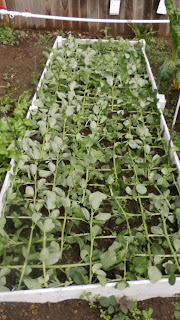Yet Seattle, like any city, ever-develops. (Track current construction projects in Seattle here.) Buildings come down in a day and new ones take forever to go up. The need to improve and create beauty stimulates renovation of all types. Ironically, landscape construction projects that will probably only last in the short term (before the next project comes along) can harm the long-term residents of it's site: the trees.
According to the International Society of Arboriculture, construction is one of the greatest causes of tree decline and death in urban environments (Arborist's Certification Study Guide, 2010). Trees may become stressed by physical damage to the trunk, branches and root systems, especially when re-grading must be done. Compaction (reduced pore space in soil that creates less aeration) occurs by heavy equipment constantly coming and going, as well as increased foot traffic. This causes reduced oxygen and increased carbon dioxide in the soil, as well as reduced water infiltration. Unfortunately the impact of these stresses may not show up for years, in the form of diseases and shortened life span.
Fortunately through trial and error, the City of Seattle has developed a set of regulations for protecting trees during construction projects, as found in the Tree Protection Ordinance (SMC 25.11) and Environmentally Critical Area Code (SMC 25.09). Read them here. There are three categories of trees covered by these regulations: 1) larger than 6" in diameter and taller than 4.5', 2) exceptional trees (those with high value for various reasons), and 3) hazardous trees. One category of trees that does not seem to be covered are very young trees.
The city claims to follow best practices developed by Oregon State University Extension. These guidelines are designed to preserve and protect tree health by minimizing disturbance to tree roots, the trunk or crown. For example, in order to protect the Critical Root Zone (CRZ, measured at 1 foot of radius outward from the base of the tree, per inch of diameter at 4.5' up the trunk from the base of the tree) strong fencing should be installed, with appropriate signage - as seen in the photo below:
[From SDOT Blog, City of Seattle, accessed 11/2/16]
[From Dubose Tree Service, accessed 11/2/16]
It seems doubtful whether the regulations for protecting the CRZ are enough to protect roots from being severed, or to avoid damage to finer absorbing roots (which uptake nutrients and water). So really we are talking about mitigation. Enough planning in advance may minimize damage, and preparations for follow up tree care may help the tree heal from stresses incurred - call this "protection" if you want. Follow up maintenance strategies outlined by city protocol include mulch, fertilization (after one year), irrigation and pruning. Also trees should be inspected for 3-5 years after construction ends. Again we ought to ask - is five years enough time to determine the affect of a particular construction project on a tree's health? Clearly it's all a gamble.
One final photo to contemplate:
[From treesolutions.net, accessed 11/2/16]
First visualize what you believe the CRZ to be. Ask if the fencing is enough to protect the crown of this particular tree? Notice the cement terracing. This is another mitigation strategy to minimize the severing of roots when re-grading must occur. Additionally, if roots must be severed, the City advocates for "clean cuts". Do you believe damage and stress has been avoided in this picture? What do you think the tree will look five years from now? Will there be any die back? How long is this tree going to live?
Again take a look at the development map mentioned at the beginning: Seattle in Progress. How many trees do you imagine are being impacted in our city right now by construction, and how many are being properly cared for, throughout and after the process? How many trees will have the long full lives they might have had without the construction project carried out?
Works Cited
Lily, Sharon J. Arborist's Certification Study Guide. 3rd Ed. (International Society of Arboriculture, 2010).
Tree Protection Code. Seattle Department of Construction & Inspections. Web. November 2, 2016. http://www.seattle.gov/dpd/codesrules/codes/treeprotection/
"Tree Protection of Construction and Development Sites: A Best Management Practices Guidebook for the Pacific Northwest". Oregon State University Extension. December 2009. Web. November 2, 2016. http://www.seattle.gov/dpd/cs/groups/pan/@pan/documents/web_informational/p2209364.pdf.
















.jpg)